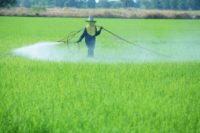Campylobacter spp. are currently regarded as the leading cause of bacterial gastroenteritis in humans and are recognized as a leading cause of bacterial foodborne diarrheal disease worldwide.[1] Symptoms range from mild to serious infections and may lead to permanent neurological symptoms. The vast majority of cases occur as isolated, sporadic events. According to the U.S. Centers for Disease Control (CDC), about 13 cases are diagnosed each year for each 100,000 persons in the population. It is believed that more cases go undiagnosed or unreported, and that campylobacteriosis could affect over 2.4 million persons every year.
.jpg) Campylobacteriosis is an infection caused by Campylobacter, most commonly C. jejuni. It produces an inflammatory, sometimes bloody, diarrhea or dysentery, including cramps, fever and abdominal pain.
Campylobacteriosis is an infection caused by Campylobacter, most commonly C. jejuni. It produces an inflammatory, sometimes bloody, diarrhea or dysentery, including cramps, fever and abdominal pain.
The debilitating neurological disorder, Guillain-Barre syndrome, as well as reactive arthritis have also been associated with recent infections with certain C. jejuni strains. The CDC estimate that one in every 1,000 reported Campylobacter illnesses leads to Guillain-Barré syndrome and as many as 40% of cases in this country may be triggered by campylobacteriosis.
C. lari and the emerging pathogen C. upsaliensis have also been reported in a small percentage of cases of human Campylobacter infection. Campylobacter spp. are highly infectious: as few as 500 bacteria can cause illness. Campylobacter infections are usually caused by consuming cross-contaminated or insufficiently processed food (typically red meat, poultry, shellfish and unpasteurized milk). Less common are infections due to eating contaminated fruit and vegetables. In addition, water contaminated with animal and avian feces, agricultural run-off and sewage effluent can act as sources for infection with Campylobacter bacteria.
The organism is a cytochrome oxidase positive, microaerophilic, curved Gram-negative rod exhibiting corkscrew motility and is carried in the intestine of many wild and domestic animals, particularly avian species including poultry.
There is an increasing demand for Campylobacter testing in food to meet new regulations regarding levels in poultry. The majority of Campylobacter spp. are relatively metabolically inactive, making identification based on biochemical characteristics difficult. Currently, the most commonly used techniques to test food products for Campylobacter are traditional methods based on culture media. The standard detection method involves enrichment for 48 hours, followed by isolation on selective agars, which takes an additional 48 hours before identification testing can be initiated. Both culture steps have to be carried out in a microaerophilic environment in which oxygen concentrations are lower than those present in the atmosphere. The method is time-consuming and labor-intensive and as such, final identification results are only available after 4 to 5 days.[2]
The United States and European Union are increasing their focus on consumer health and food safety, especially in relation to Campylobacter infection. The Dutch “Campylobacter Risk Management and Assessment” project concluded that the primary source of human Campylobacter infection is fresh poultry meat derived from high shedding broiler flocks (those excreting log 7 to log 8 CFU Campylobacter spp. per gram feces).[3] The study concluded that campylobacteriosis could be effectively reduced by identifying and eliminating high shedding flocks, pre-slaughter, from fresh poultry meat production.
The demand for a commercially available rapid test for identification of such high shedding C. jejuni and C. coli flocks, pre-slaughter, has been outlined in a feasibility study completed in the United Kingdom by the Animal Health and Veterinary Laboratories Agency.[4] In 2011, the Department for Environmental Food and Rural Affairs’ project OZ0621 concluded that the rapid test should have a time-to-result of within two hours, and be suitable for use on the farm without laboratory staff or facilities.[4] A lateral flow device (LFD; Figure 1) was considered the method with most potential.
Below, we describe development and application of an immunological rapid screening process based on lateral flow technology that meets these study criteria of test-to-result in 2 hours and no requirement for laboratory-trained personnel.
In independent field studies, using a cross-seasonal representative set of fecal samples, the Campylobacter LFD (EMD Millipore, Billerica, MA) was compared to the standard ISO/TS 10272-2 culture method.[1] In one study, both LFD and culture methods were compared to real-time PCR to study the flock prevalence.
The EMD Millipore assay is a gold-labelled immunosorbent assay (GLISA) based on immunochromatographic (lateral flow) technology. Target antigens in the chicken fecal sample, in this case C. jejuni/C. coli, are applied to the device and bind to highly specific gold-labelled antibodies, which flow in a bound complex over a nitrocellulose membrane and attach to highly specific capture antibodies immobilized onto the membrane. As antigen-gold-labelled antibody complexes accumulate in this zone, the red color from the gold label intensifies, enabling visualization of the immune reaction.
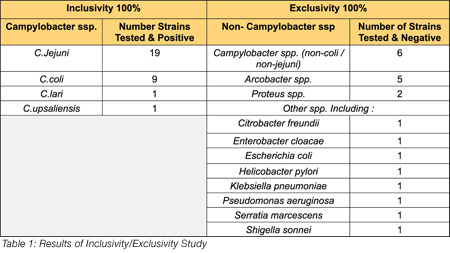 Pure culture studies were initially performed followed by field studies. Table 1 summarizes the results of the inclusivity/exclusivity study using pure strains of thermophilic Campylobacter spp. (inclusivity; 30 strains), non-thermophilic Campylobacter spp. and non-Campylobacter spp. (exclusivity; 31) that were cultivated in Bolton Broth (no Laked Horse Blood) for 48 hours. All strains were obtained from the DSMZ reference culture collection German Type Strain Collection. As shown in Table 1, all Campylobacter strains tested could be specifically detected by this method, with no cross-reaction observed for any non-Camplyobacter strain, leading to 100% inclusivity and exclusivity rates.
Pure culture studies were initially performed followed by field studies. Table 1 summarizes the results of the inclusivity/exclusivity study using pure strains of thermophilic Campylobacter spp. (inclusivity; 30 strains), non-thermophilic Campylobacter spp. and non-Campylobacter spp. (exclusivity; 31) that were cultivated in Bolton Broth (no Laked Horse Blood) for 48 hours. All strains were obtained from the DSMZ reference culture collection German Type Strain Collection. As shown in Table 1, all Campylobacter strains tested could be specifically detected by this method, with no cross-reaction observed for any non-Camplyobacter strain, leading to 100% inclusivity and exclusivity rates.
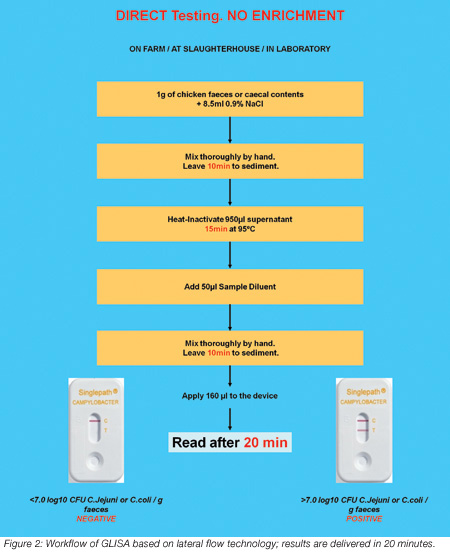 Field studies were conducted on the farm and at the slaughterhouse, testing chicken feces and cecal contents, to evaluate performance of the rapid lateral flow test compared to the standard culture ISO/TS 10272-2 method,[2] and in one study also to real-time PCR, using broiler chicken fecal samples. Figure 2 summarizes the EMD Millipore assay sample preparation method. It is a simple procedure requiring no enrichment step. It requires dilution of the chicken feces or cecal contects in 0.9% sodium chloride, heat-inactivaton at 95ºC for 15 minutes, dilution with the kit sample diluent and application of the sample to the lateral flow device, with a time-to-result of 20 minutes. Real-time PCR was performed in a Light-cycler 2.0 (Roche Diagnostics, Germany).
Field studies were conducted on the farm and at the slaughterhouse, testing chicken feces and cecal contents, to evaluate performance of the rapid lateral flow test compared to the standard culture ISO/TS 10272-2 method,[2] and in one study also to real-time PCR, using broiler chicken fecal samples. Figure 2 summarizes the EMD Millipore assay sample preparation method. It is a simple procedure requiring no enrichment step. It requires dilution of the chicken feces or cecal contects in 0.9% sodium chloride, heat-inactivaton at 95ºC for 15 minutes, dilution with the kit sample diluent and application of the sample to the lateral flow device, with a time-to-result of 20 minutes. Real-time PCR was performed in a Light-cycler 2.0 (Roche Diagnostics, Germany).
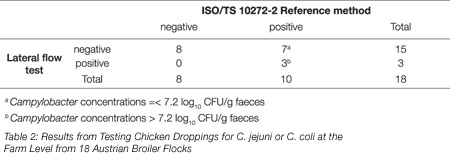 Table 2 shows the results from on-farm testing of chicken droppings for C. jejuni or C. coli from 18 Austrian broiler flocks. The lateral flow assay detected all high shedding flocks. Table 3 shows results pre-slaughter of naturally contaminated chicken cecal contents from 187 broiler flocks. The lateral flow assay identified 102 C. jejuni- and/or C. coli-positive flocks out of the 103 positive high-shedding flocks detected by culture (a sensitivity of 99%). Eleven flocks not detected by lateral flow were less than 7.0 log10 CFU Campylobacter spp./g feces and therefore not considered as high-shedding flocks. Real-time PCR revealed 134 C. jejuni and/or C. coli positive flocks out of 187 (71% prevalence and higher than the 61% identified by culture).
Table 2 shows the results from on-farm testing of chicken droppings for C. jejuni or C. coli from 18 Austrian broiler flocks. The lateral flow assay detected all high shedding flocks. Table 3 shows results pre-slaughter of naturally contaminated chicken cecal contents from 187 broiler flocks. The lateral flow assay identified 102 C. jejuni- and/or C. coli-positive flocks out of the 103 positive high-shedding flocks detected by culture (a sensitivity of 99%). Eleven flocks not detected by lateral flow were less than 7.0 log10 CFU Campylobacter spp./g feces and therefore not considered as high-shedding flocks. Real-time PCR revealed 134 C. jejuni and/or C. coli positive flocks out of 187 (71% prevalence and higher than the 61% identified by culture).
In summary, the 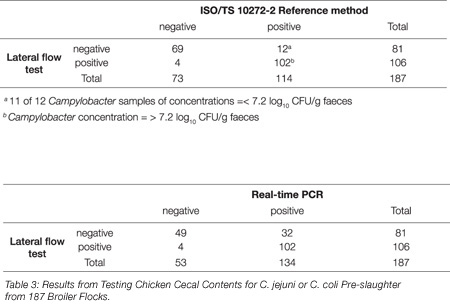 rapid screening lateral flow test described can deliver results within two hours with no enrichment required. The test can be performed directly on farm or by any person without training. The test reliably identifies high shedding (>7.2 log10 CFU/g feces) C. jejuni and C. coli broiler flocks on farm or pre-slaughter, and could be used as an effective tool for a Campylobacter risk management program.
rapid screening lateral flow test described can deliver results within two hours with no enrichment required. The test can be performed directly on farm or by any person without training. The test reliably identifies high shedding (>7.2 log10 CFU/g feces) C. jejuni and C. coli broiler flocks on farm or pre-slaughter, and could be used as an effective tool for a Campylobacter risk management program.
For more information, please contact lisa.john@merckgroup.com, Phone: +49 (0) 6151 72 9504.
References
1. www.cdc.gov/nczved/divisions/dfbmd/diseases/campylobacter.
2. www.iso.org/iso/iso_catalogue/catalogue_tc/catalogue_detail.htm?csnumber=37092.
3. www.rivm.nl/carma/resultaten/Euroforum%2020020925/index.htm.
4. randd.defra.gov.uk/Default.aspx?Menu=Menu&Module=ProjectList&Completed=0&AUID=1205.

